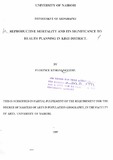| dc.description.abstract | This study was an attempt to investigate the phenomenon of reproductive mortality in Kisii district. The broad objectives were to estimate the levels, portray the trend and identify the determinants of maternal mortality and its significance to health planning. The specific objectives included evaluating the impact of distant factors, reproductive and health status, and health care behaviour as independent variables on influencing maternal deaths.
The research was carried out in two hospitals in Kisii district. Involved were one government assisted hospital (Kisii District Hospital) and one mission hospital (Tabaka Mission Hospital). The period of study was five years i.e 1991-1995. Data for this study was obtained from both secondary and primary sources. The data collected during the field study included data on distant determinants (factors) namely occupation and place of residence; data on reproductive status namely age, parity, marital status and birth interval; data on health care behaviour/use of health services namely antenatal clinic attendance and mode of delivery and lastly data on health status namely infection and parasitic diseases.
Demographic (maternal mortality ratio and maternal mortality rate), and statistical (regression analysis, correlation analysis and factor analysis) techniques were used to identify the trend and establish whether there was any significant relationship between maternal mortality and the independent variables (socio-economic factors, reproductive and health status, and health care behaviour). The significance of parity was tested using the F-ratio test at significance level
0.95.
The research revealed that Kisii District has a high maternal mortality ratio and this has been rising since 1991. In 1991 the maternal mortality ratio as 397.5 deaths per 100,000 live births; 488.2 in 1992; 530 in 1993; 620 in 1994; and 663 in 1995. This was attributed to early age of marriage, high total fertility rate, marital status and occupation among others.
Further analysis using regression analysis revealed that there existed negative and strong relationships between age and birth interval, and parity; and maternal death, respectively. Age had a correlation coefficient of 0.32576 and a correlation of determination of 10.6 percent. While birth interval had a correlation coefficient of 0.44997 and correlation of determination of
20.2 per cent. Parity which had the strongest association had a correlation coefficient of 0.9812
and a correlation of determination of 97.4 per cent. It was also found that marital status,
-- iii
occupation, and place of residence played a crucial role in influencing maternal mortality. Factor analysis identified five determinants of reproductive mortality in the study area namely; health seeking behaviour, demographic events, occupation, mode of delivery and birth interval.
On the basis of the results obtained in this study, it was recommended that there should be an effective formulation and dissemination of education: and maternal and child care (MeR) programmes based on the understanding of the interactive impact of the above factors (socio economic factors, reproductive and health status, and health care behaviour) as they affect mothers during pregnancy and child birth. | en |

